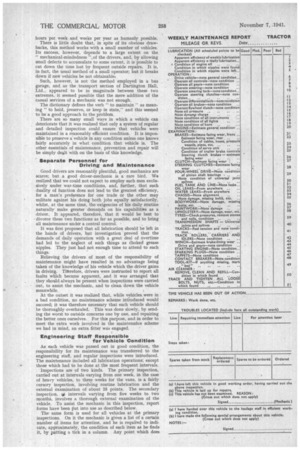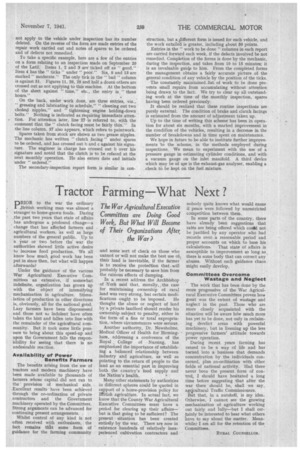WAR LEADS to DRASTIC REVISI
Page 26

Page 27

Page 28

Page 29

If you've noticed an error in this article please click here to report it so we can fix it.
of MAINTENANCE METHODS
AT the hard school of experience, lessons are well learnt. But how much better to profit from the experience of others. Here is a story of casual methods of maintenance that led nearly to the brink of disaster, that teaches a moral, and that resulted in the development of a system which other operators might well adapt to their own requirements and advantage.
Telling of the time when a full realization of the position was brought home to him, our friend whom the story concerns said: " A thorough inspection of the fleet was disconcerting. All vehicles were deteriorating and some were in a very bad state. The heavy vehicles called upon to work in feet of mud and the crawler tractors, often operating on hillsides like the wall of a house, had suffered worst.
"What was the reason for this state of affairs?"
Before relating the answer to this question and describing the steps taken to extricate the fleet from out of the mud and to keep it on fair ground thereafter, let us explain about whom and what we are writing.
The operator is Dartington Hall, Ltd., Totnes, Devon, the transport department of which, under the control of Mr. J. F. Eden, B.Sc., A.M.I.Mech.E., is engaged on timber transport, on delivering cider and green crops within a 30-mile radius, on a local house-to-house milk round and a daily station round, on carting manure in large quantities from sewage dumps in the vicinity to the orchard farm and market gardens, on a local refuse round, and on the disposal of sawdust from the company's saw mill.
This, indeed, presents a varied picture.
Working in connection with the saw mill are two Caterpillar tractors, employed in extracting timber from woods up to 60 miles away, two oil-engined winch-equipped, road tractors—a Foden and a Latil—used to bring in timber on home-made trailers believed to incorporate in their make-up old Peerless lorry axle components, and two articulated outfits with Diamond-T and International tractive units.
Performing ordinary transport duties are four tippers, of 30-cwt. and 2-ton capacities (three of which are hired and are maintained efficiently by their owners), a Commer 3-tonner, a Morris-Commercial 4-ton lorry and two vans (also hired) for 10-cwt. and 5-cwt, loads respectively and used almost exclusively by the poultry department—quite a mixed fleet. Now over, once more, to Mr. Eden.
The maintenance of our own vehicles, he says, hrought a number of problems which increased as the fleet was enlarged, and were rendered acute by war-time conditions. lip to the outbreak of war, as in many other smaller concerns, the maintenance of vehicles was largely carried out by drivers, who also did minor repairs. In this they were assisted by the sawmill mechanics, when they could be spared. All major repairs were done by outside Concerns.
The strain of wartime production on , -drivers and vehicles,
• the call up of men, the difficulty -in obtaining new vehicles and spares, and the delay in repairs, crowned by a number of breakdowns, led, in the summer of 1940, to a review of the problem.
Comparatively large sums of money bad been spent on repairs, and the Maintenance allotted to drivers bad not been overlooked. The prevalent concept of maintenance appeared to be that it was largely a question of repairs and that, apart from routine matters, such as lubrication, a vehicle should not be brought in from the road unless there was something wrong with it. It was thought that preventive maintenance could best be left in the hands of drivers and that any further insistence on such matters would lead to a defeat of the main object, which was agreed to constitute keeping the vehicles on the road for as many hours per week and weeks per year as humanly possible.
There is little doubt that, in spite of its obvious drawbacks, this method works with a small number of vehicles. Its success, however, depends to a large extent on the " mechanical-mindedness ".of the drivers, and, by allowing small defects to accumulate to some extent, it is possible to cut down the time lost by frequent outside repairs. It is, in fact, the usual method of a small operator; but it breaks down if new vehicles be not obtainable, Such, however, is not the method employed in a bus garage, and as the transport section of Dartington Hall, Ltd., appeared to be in magnitude between these two extremes, -it seemed possible that the mere addition of the casual services of a mechanic was not enough.
The dictionary defines the verb "to maintain" as meaning "to hold, preserve, or keep in state," and this seemed to be a good approach to the problem.
There are so many small ways in which a vehicle can deteriorate that it was realized that only a system of regular and detailed inspection could ensure that vehicles were
maintained in a reasonably efficient condition. It is impossible to preserve a: vehicle in any condition unless one knows
fairly accurately in what condition that vehicle is. The other essentials of maintenance, prevention and repair will be simply dealt with on the basis of this knowledge.
Separate Personnel for Driving and Maintenance Good drivers are reasonably plentiful, good mechanics are scarce; but a good driver-mechanic is a rare bird. We realized that we could not expect to employ such men exclusively under war-time conditions, and, further, that such duality of function does not lead to the greatest efficiency, for a man's preference for one trade or the other may militate against his doing both jobs equally satisfactorily, whilst, at the same time, the exigencies of his daily routine naturally make greater demands on his capabilities as a driver. It appeared, therefore, that it would be best to 'divorce these two functions as far as possible, and to bring all maintenance under a central control.
It was first proposed that all lubrication should be left in the hands of drivers, but investigation proved that the demands of daily operation with a great deal of overtime had led to the neglect of such things as Choked grease nipples. They just had not enough time to attend to such things.
Relieving the drivers of most of the responsibility of maintenance might have resulted in no advantage being taken of the knowledge of his vehicle which the driver gains in driving. Th'erefore, drivers were instructed to report all faults which became apparent, and it was arranged that they should always be present when inspections were carried out, to assist the mechanic, and to clean down the vehicle meanwhile.
At the outset it was realized that, while vehicles were in a bad condition, no maintenance scheme intioduced would succeed; it was therefore necessary that each vehicle should be thoroughly overhauled. This was done slowly, by sending the worst to outside concerns one by one, and repairing the better ones ourselves. For this purpose, and in order to meet the extra work involved in the maintenance scheme we had in mind, an extra fitter was engaged.
Engineering Staff Responsible for Vehicle Condition As each vehicle was passed out in good condition, the responsibility for its maintenance was transferred to the engineering staff, and regular inspections were introduced. The maintenance included all lubrication operations, except • those which had to be done at the most frequent intervals. Inspections are of two kinds, The primary inspection, carried out at intervals varying from one week, in the case of heavy vehicles, to three weeks for the vans, is a fairly cursory inspection, invob:ring routine lubrication and the external examination of about 25 points. The secondary inspection, 4,t intervals varying from five weeks to two monthe, involves a thorough external examination of the vehicle. To assist the mechanic in this inspection, report forms have been put into use as described below.
The same form is used for all vehicles at the primary inspections. On it the mechanic is given a list of a certain number of items for attention, and he is required to indicate, approximately, the condition of each item as he finds it, by putting a tick in a column. Any point which does not apply to the vehicle under inspection has its number deleted. On the reverse of the form are made entries of the repair work carried out and notes of spares to be ordered and of defects not remedied.
To take a specific example, here are a few of the entries on a form relating to an inspection made on September 20 of the Latil: Items 1, 2 and 9 are' ticked off as " good." Item 4 has the " ticks" under' poor." Six, 8 and 13 are marked " moderate." The only tick in the" bad" column is against 51. Figures 11, 26, 28 and half a dozen others are crossed out as not applying to this machine. At the bottom of the sheet against " time," etc., the entry is " three hours."
On the back, under work done, are three entries, viz., " greasing and lubricating to schedule," "cleaning out two choked nipples," and "tightening engine holding-down bolts." Nothing is indicated as requiring immediate attention. For attention later, line 27-is referred to, with the comment that the " clutch facing must be fairly thin." In the line column, 37 also appears, which refers to paintwork.
Spares taken from stock are shown as two grease nipples. The mechanic has written " clutch facing " under spares to be ordered, and has crossed out b and c against his signature. The engineer in charge has crossed out b over his signature and noted that the clutch is to be refaced at the next monthly operation. He also enters date and initials under "ordered."
The secondary-inspection report form is similar in con struction, but a slifferent form is issued for each vehicle, and the work entailed is greater, including about 50 points.
Entries in the " work to be done "columns in each report are carried forward each week, if the defects involved be not remedied. Completion of the forms is done by the mechanic, during the inspection, and takes from 10 to 15 minutes; it is an invaluable guide to him. From the completed forms the management obtains a fairly accurate picture of the general condition of any vehicle by the position of the ticks.
The constantly maintained .list of work to be done prevents small repairs from accumulating without attention being drawn to the fact. We try to clear up all outstanding work at the time of the monthly inspection, spares having been ordered previously.
It should be realized that these routine inspections are purely external. The condition of brake and clutch facings is estimated from the amount of adjustment taken up.
Up to the time of writing this scheme has been in operation for about six months, with a marked improvement in the condition of the vehicles, resulting in a decrease in the number of breakdowns and in time spent on maintenance.
We hope in future to be able to institute further improvements 'to the scheme, in the methods employed during inspections. We mean to experiment with the use of a pressure gauge in estimating cylinder conditions, and with a vacuum gauge on the inlet manifold. A third device which may be of use is the exhaust-gas analyser, enabling a check to be kept on the fuel mixture.




















































